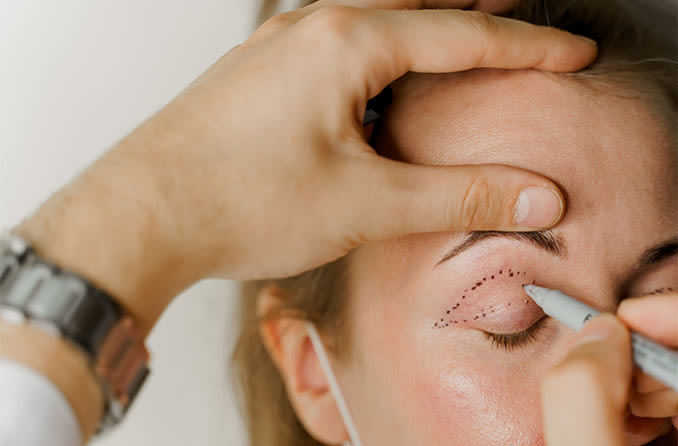For most people, their confidence, personality, and measure of their beauty lies within their eyes, and their overall physical appearance. Unfortunately, this is not the case for everyone as birth defects, traumatic accidents, and the aging process may be an obstruction.
Thanks to medical and cosmetic surgeons like Dr. Debraj Shome, these issues can easily be corrected and restore an individual’s pride in their appearance. Ptosis surgery is one such effective procedure that can significantly improve a person’s confidence and eye functionality.
What is Ptosis Surgery?
Ptosis is a medical condition where the upper eyelids tend to droop down to an extent that it interferes with one’s vision. It can also be a cosmetic issue. Thankfully, medical and cosmetic surgeons can correct this through Ptosis surgery.
The surgeon makes an incision during the surgery through which he can work. The technique is to lift and reposition the muscles that support the eyelids to the normal position to restore the field of vision.
There are many other different techniques a surgeon can use to correct Ptosis. The approach used depends on how severe the Ptosis is as well as the goals of the patient. Usually, the procedure is done on an outpatient basis.
It is important that any kind of surgery should be performed by a qualified cosmetic surgeon, who is board-certified and has experience. The patient must also look for a reputable clinic like The Esthetic Clinics that specializes in the respective field.
Diagnosing Ptosis Surgery
When a patient visits a Ptosis surgery clinic, the first thing a professional should do is consultation and assessment. Diagnosis includes performing a comprehensive eye examination. Typically, the surgeon measures the distance between the margin of the upper eyelid and the pupil in both primary and upward gaze. The distance in this measurement is what may indicate Ptosis.
Other tests the doctor will perform include a visual field test to determine if the field of vision is being blocked by Ptosis and a levator function test to measure the strength of the levator muscle. Visual field test measures the peripheral vision of the patient to determine if the ptosis is obstructing their field of vision.
If and when ptosis is diagnosed, the surgeon and the patient can start planning for the surgery. This is where the doctor explains in detail about the procedure and what will happen before, during, and after the surgery. Patients are also advised to be clear about ptosis surgery cost right from the beginning.
Who is it for?
Ptosis surgery is usually for people with droopy eyelids due to weak muscles. It makes the patient look sleepy and tired and may be performed just for cosmetic reasons to look better, more alert, and more confident. It may also be prescribed by a medical doctor to improve the vision of the patient.
Here are some factors that may make someone a good candidate for ptosis surgery:
Significant ptosis: Ptosis surgery is typically prescribed for people with significant Ptosis. This means their eyelids are significantly lower than they should be, to the extent that it becomes uncomfortable for the patient or cause vision obstruction.
Good overall health: Before any surgery is done, doctors must assess the patient to ensure they don’t have any other health complications that may cause problems during the procedure. The same goes for Ptosis surgery. This will help to minimize the risk of complications and support successful results.
Realistic expectations: Sometimes cosmetic surgery may be exaggerated, which leads to patients having unrealistic expectations. A cosmetic surgeon should explain in detail what the surgery can and cannot achieve. Patients should know that the surgery may improve their appearance and vision, but may not completely eliminate all the symptoms of Ptosis.
Stable vision: The surgeon must ensure that the patient’s vision has not changed significantly to the extent that it will affect the outcome of the surgery.
Willingness to follow instructions: While ptosis is not such a major procedure, patients must be ready to abide by the surgeons’ instructions as soon as they start consultations. This means before, during, and especially after the surgery. They must be willing to make some minor changes in their daily life activities until they heal or the doctor relieves them of the instructions.
Besides those recommended by doctors, anyone who feels like they need to work on their eyelids can be a good candidate for ptosis surgery. What’s important is that they first consult with a medical or cosmetic surgeon to determine if the procedure can achieve their goals so they know what to expect.
Types of Ptosis Surgery
There are different techniques a surgeon can use to address the ptosis issue. The approach used depends on a variety of factors such as the severity of the ptosis and the underlying cause of the condition.
- Levator resection
This is probably the most common type of ptosis surgery as it accounts for at least 90% of all ptosis cases. As the name suggests, it involves working on the levator muscle. This muscle is responsible for lifting the eyelid, and the surgeon works to shorten and tighten it.
An incision is made in the eyelid crease and a small amount of tissue is removed after which the muscle is reattached to a higher position on the eyelid. The result is a more lifted and symmetrical appearance of the eyelids.
The procedure is performed under anesthesia and is generally considered safe. Patients might however experience bruising, swelling, and a little discomfort, after the surgery and a few days following. Eye drops and ointments may be prescribed to help relieve pain and swelling and enhance healing.
Recovery time after surgery is different for every patient and varies depending on multiple factors. Generally, most patients are ready to go back to their daily lives within 1-2 weeks.
There are many reasons and benefits for doing this surgery. For starters, it can help restore or improve a patient’s field of vision if the drooping eyelid was affecting their ability to see. It can also improve the appearance of an individual, making their eyes look more open and alert.
Some risks associated with levator resection include bleeding, infection, asymmetry, and overcorrection or under-correction of the eyelid position. In case of any of these concerns, or any other concern arises, patients are urged to immediately see their surgeons.
- Müller muscle resection
Müller muscle resection is usually performed on the muller muscles located just below the levator muscle, where the drooping eyelid is caused by its weakness. During the procedure, the surgeon makes an incision in a thin membrane that covers the white part of the eyes, called the conjunctiva. He then removes a small segment of the muscle to lift the eyelid.
Compared to levator resection, Müller muscle resection is less invasive and more targeted. It is usually done to people with mild or moderate Ptosis and can correct age-related drooping of the eyelids.
A few days following the surgery, patients may experience symptoms such as bruising and swelling around the eye, which usually go away on their own a few days later. Eye drops and ointments can help with the pain and prevent infection.
The good thing is that the surgeon performs the procedure under anesthesia to make it comfortable and less painful for the patients. It also only takes less than an hour and most patients can return home the same day.
One advantage of undergoing this procedure is that it can improve a person’s appearance as well as their visual function if the condition was affecting their vision. It can also boost self-esteem and confidence.
Some risks and complications of Müller muscle resection may include bleeding, infection, asymmetry, and overcorrection or under correction of the eyelid position. In case of any of these, it is important for patients to immediately let their surgeon know, for the necessary measures to be taken.
- Frontalis suspension
Frontalis suspension can be performed when ptosis is caused by a weak or absent levator muscle. The purpose of the surgery is to attach the eyelid to the frontalis muscle (located in the forehead).
During the procedure, the surgeon creates a small incision in the eyelid to attach a small piece of material (a silicone rod or suture) to the eyelid and the frontalis muscle, to allow the eyelid to lift when the patient raises their eyebrows.
Frontalis suspension is mostly performed on children who have congenital ptosis, as well as adults who have acquired ptosis from injuries or neurological conditions.
During the procedure, the patients are put under anesthesia with sedation so the whole process is painless and comfortable. However, after the surgery, many patients report experiencing bruising and swelling.
There may also be some risks just like with any other procedure, such as bleeding, infections, and asymmetry.
But the benefits make it worth a try. One of the main advantages is that it provides a long-lasting and stable result. However, patients may need to make more appointments with their surgeons as the material used in the eyelid may lose elasticity with time.
It improves the patient’s appearance, making them more confident and happier, and may also be a solution to vision impairments caused by ptosis.
- Whitnall sling
Whitnall sling is almost similar to frontalis suspension only that the surgeon uses a different type of material to suspend the eyelid. In this procedure, a small incision is created in the eyelid and a sling, mostly made of a synthetic material, is attached to the upper part of the eye socket. The patient’s own tissue can also be used instead of the synthetic material.
This provides support to the eyelid and helps to lift it to a more natural position. The procedure is often used where the ptosis is caused by a weak or an absent levator and can be an effective alternative to frontalis suspension.
Local anesthesia is administered with sedation to make the process easy for both the surgeon and the patient. After the surgery, patients may experience a little swelling and discomfort for a few days, before the symptoms subside on their own.
There may be some risks and complications associated with the procedure such as overcorrection, under-correction, bleeding, and infections. Some of these can be easily treated while others may require revision surgery. It is important for patients to consult with their doctors in case they experience any of these symptoms.
On the good side, the surgery has multiple advantages. One of the best things about it is that it can be customized to the patient’s specific needs, which allows for precise control of the eyelid position and movement. It is also a more natural and long-lasting solution compared to most of its alternatives.
Undoubtedly any type of Ptosis surgery is highly effective in correcting drooping eyelids. It all just depends on the severity of the condition and the goals of the patient. A professional cosmetic surgeon like Dr. Debraj Shome should also give the necessary advice to ensure realistic expectations.
Note that choosing a well-reputed ptosis surgery clinic where patients can be comfortable and get specialized care, is crucial.
Ptosis Surgery Procedure
Ptosis surgery procedures can be different depending on the severity of the condition and how much it has affected the patient. Some ptosis can affect the eyes partially while others can have a full effect. It can also affect one or both eyes.
The cause and type of Ptosis can determine the procedure. Some causes are age, injuries, neurological disorders, and muscle weakness.
During the procedure, the cosmetic surgeon focuses on reworking the eyelid back to its natural place. In most cases, the goal of the surgery is to lift the eyelid to stop covering the eye and improve vision.
Patients can expect to go home the same day, as the procedure is performed on an outpatient basis and only takes 30 to 45 minutes.
Local anesthesia is administered before the surgery to numb the area where the surgeon will work on. A small incision is then made in the crease of the upper eyelid or on the inside of the eyelid. The surgeon may also need to remove some excess skin and tissue if the Ptosis is severe.
Once the incision is made and the tissue removed, the surgeon will then reattach the levator muscle to the tarsal plate (a thick layer of connective tissue in the eyelid). He may also need to tighten or reposition the muscle, to achieve the desired lift.
Next, the surgeon closes the incision with sutures or surgical glue. When the procedure is over, there may be a small consultation where the patient is given a set of instructions that will help care for the surgical site and aid in faster healing.
The recovery period for ptosis surgery is different depending on a couple of factors. The extent of the surgery largely determines how long recovery will take. Patients are urged to be patient and follow the post-operative instructions.
They may experience some symptoms such as swelling and bruising around the eye, which can be managed with over-the-counter pain medications, with a doctor’s guidance.
With proper care of the surgical site, patients can return to their normal activities within a week or two. Even so, they are still not to engage in strenuous exercises and activities that could cause trauma to the eye until the doctor says it is safe.
Recovery and Support for Ptosis Surgery
Besides the physical symptoms, some patients experience mental and emotional changes too and may need support from friends, family, and even professionals.
Recovery Period;
The recovery period varies depending on different factors such as the severity of the ptosis and the type of surgical technique used. Generally, most patients take at least 2-4 weeks, but it can take up to several months for the eyelids to completely heal.
The first few days may be a little challenging as the patients experience some symptoms and the whole experience is new to them. However, it gets better with time, as they get used to it and the healing starts.
The surgeon may prescribe pain medication to manage some of the symptoms like discomfort and swelling.
Support after surgery;
Following the surgeon’s post-surgery instructions is crucial for a fast and successful recovery. Here are some tips to support the healing process:
- Rest and Relaxation
Experienced cosmetic surgeon like Dr. Debraj Shome recommends taking lots of rest, especially during the days that closely follow the surgery. Patients are advised to avoid strenuous activities that may cause complications at the surgical site. They should avoid bending over, lifting heavy objects, and any activity that strains the eye.
- Eye Care
Taking extra care of the eye after the surgery will help fasten the healing process. They should avoid rubbing their eyes, wearing contact lenses, wearing glasses (unless instructed by their surgeon), or applying makeup until the surgeon approves.
- Diet
The food we eat determines the functionality of our body. For all the body cells and organs to do their jobs accordingly, we should be able to supply them with the necessary minerals and vitamins. A healthy diet can aid in the healing process after the surgery. Patients are advised to avoid salty and spicy foods as they may cause swelling and inflammation. They should also avoid alcohol and caffeine and stay hydrated by drinking plenty of water.
- Follow-Up Appointments
There will be follow-up appointments that patients should adhere to religiously. This helps the surgeon monitor the recovery process and ensures there are no risks or complications. It also helps solve any issues that may arise immediately before it gets worse.

Cost of Ptosis Surgery in Mumbai
Ptosis surgery cost in Mumbai can be influenced by a lot of factors. There is no one price for the procedure in all of India. The cost depends on the location, the type of procedure, how bad the condition is, the level of services offered, and any additional fees for consultations and tests.
Consult with Dr. Debraj Shome to discuss your specific case and get a more customized rate for your specific needs. Checking with your health insurance provider may also help cut the cost if the procedure is eligible.


